Boyle J.A. The Cambridge History of Iran, Volume 5: The Saljuq and Mongol Periods
Подождите немного. Документ загружается.

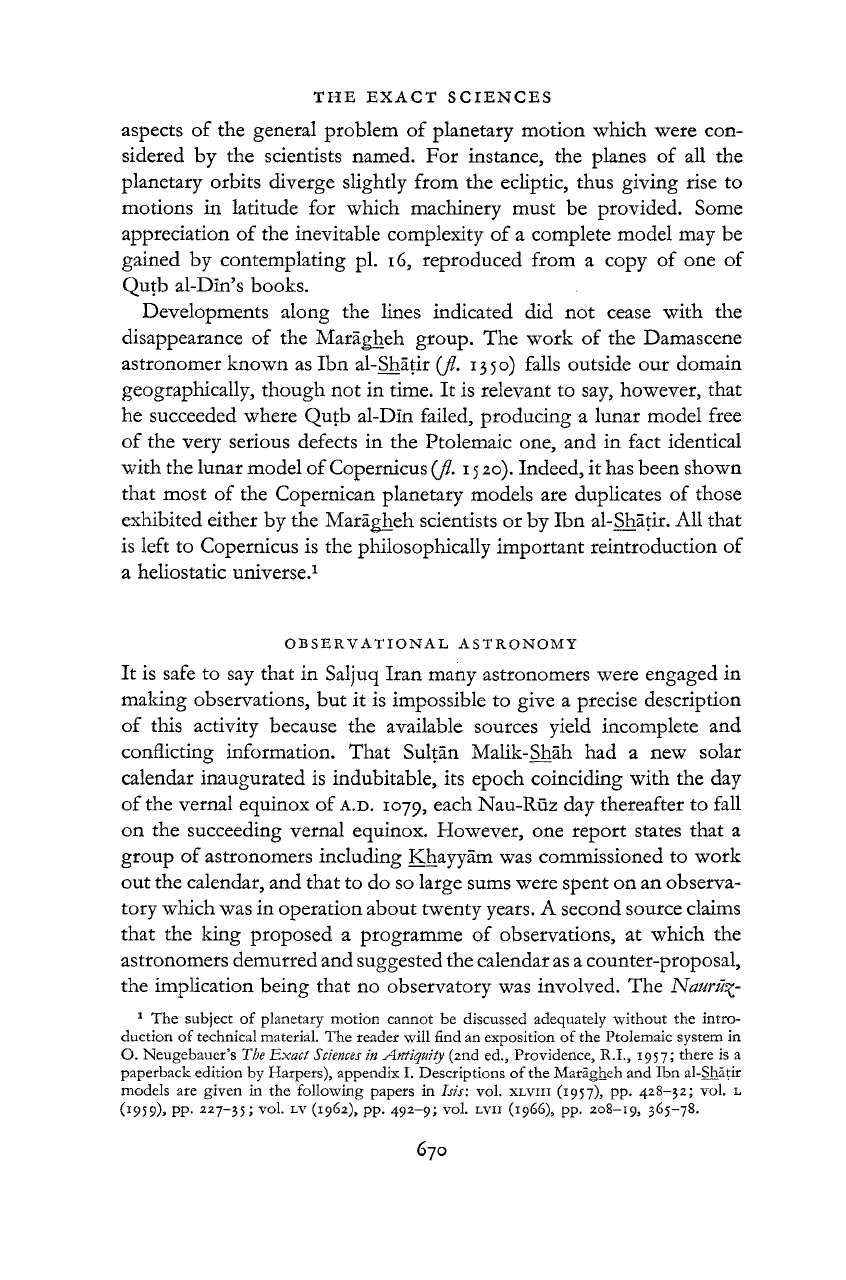
THE EXACT
SCIENCES
aspects
of the
general problem
of
planetary motion which were con-
sidered
by the
scientists named.
For
instance,
the
planes
of all the
planetary orbits diverge slightly from
the
ecliptic,
thus
giving rise
to
motions
in
latitude
for
which machinery must
be
provided. Some
appreciation
of
the inevitable complexity
of a
complete model may
be
gained
by
contemplating
pi.
16, reproduced from
a
copy
of
one
of
Qutb al-Din's books.
Developments along
the
lines indicated
did not
cease with
the
disappearance
of the
Marâgheh group.
The
work
of the
Damascene
astronomer known as Ibn al-Shâtir
(fl.
1350) falls outside
our
domain
geographically,
though
not in
time.
It
is relevant
to
say, however,
that
he succeeded where Qutb al-Din failed, producing
a
lunar model free
of
the very serious defects
in the
Ptolemaic one,
and in
fact identical
with
the lunar model of Copernicus
(y?. 15 20).
Indeed,
it
has been shown
that
most
of
the Copernican planetary models
are
duplicates
of
those
exhibited either by the Marâ
gheh scientists or by Ibn al-Shâtir. AU
that
is
left
to
Copernicus
is
the philosophically important reintroduction of
a heliostatic universe.
1
OBSERVATIONAL
ASTRONOMY
It is safe
to
say
that
in
Saljuq
Iran
many astronomers were engaged
in
making observations,
but it is
impossible
to
give
a
precise description
of
this activity because
the
available sources yield incomplete
and
conflicting
information. That Sultan Malik-Shah
had a new
solar
calendar inaugurated
is
indubitable,
its
epoch coinciding with
the
day
of
the vernal equinox of
A.D.
1079, each Nau-Ruz day thereafter
to
fall
on
the
succeeding vernal equinox. However,
one
report states
that
a
group of astronomers including Khayyam was commissioned
to
work
out the calendar, and
that
to do so large sums were spent on an observa-
tory which was in operation about twenty years.
A
second source claims
that
the
king proposed
a
programme
of
observations,
at
which
the
astronomers demurred and suggested the calendar as a counter-proposal,
the implication being
that
no
observatory was involved. The Nauru%-
1
The subject of planetary motion cannot be
discussed
adequately without the intro-
duction of technical material. The reader will find an exposition of the Ptolemaic system in
O.
Neugebauer's The
Exact
Sciences
in
Antiquity
(2nd ed., Providence, R.I., 1957; there is a
paperback
edition by Harpers), appendix I. Descriptions of the Maragheh and Ibn al-Shatir
models are given in the following papers in
I sis:
vol.
XLVIII
(1957),
pp.
428-32;
vol. L
(1959),
pp. 227-35; vol.
LV
(1962), pp.
492-9;
vol.
LVII
(1966), pp. 208-19, 365-78.
670
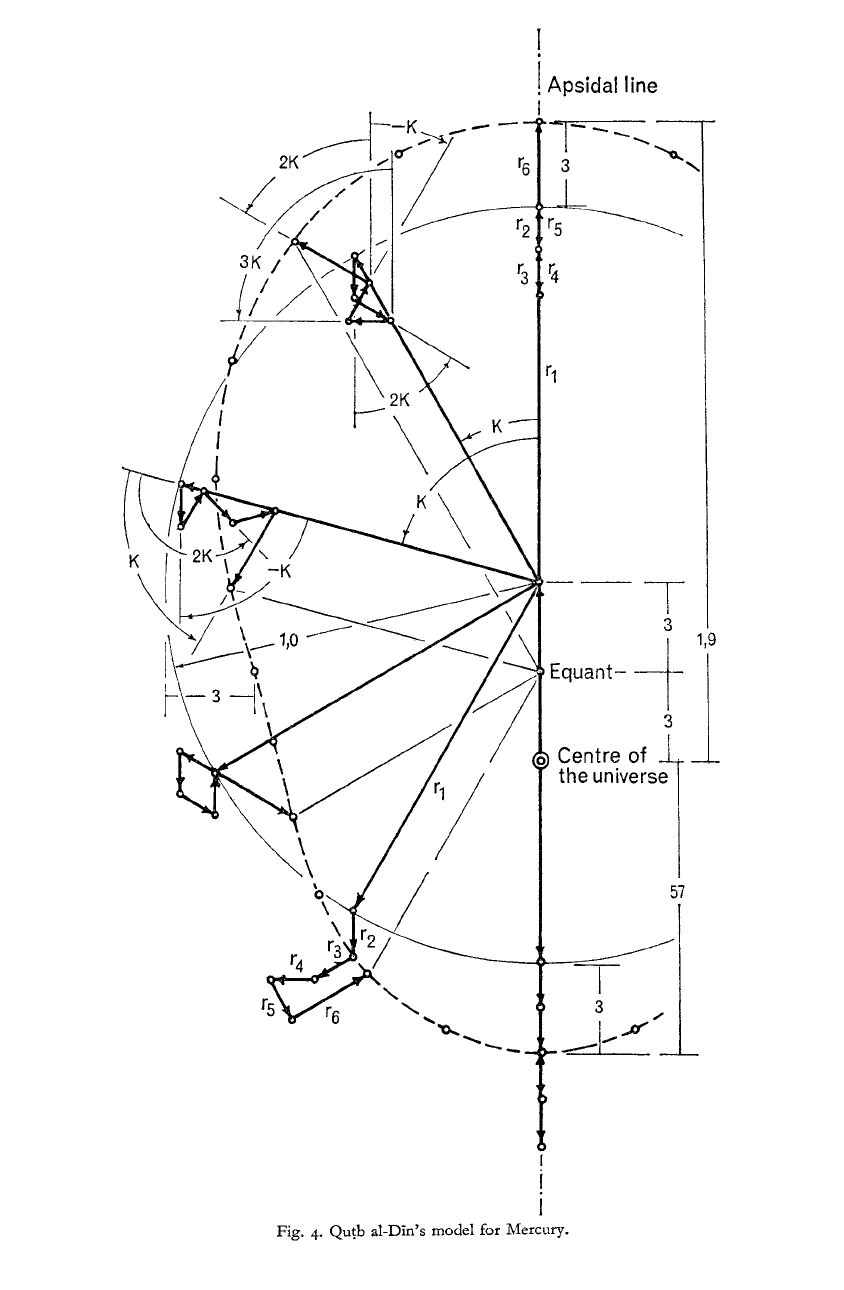
!
Apsidal
line
I
Fig.
4.
Qutb
al-Din's model for
Mercury.
Cambridge Histories Online © Cambridge University Press, 2008
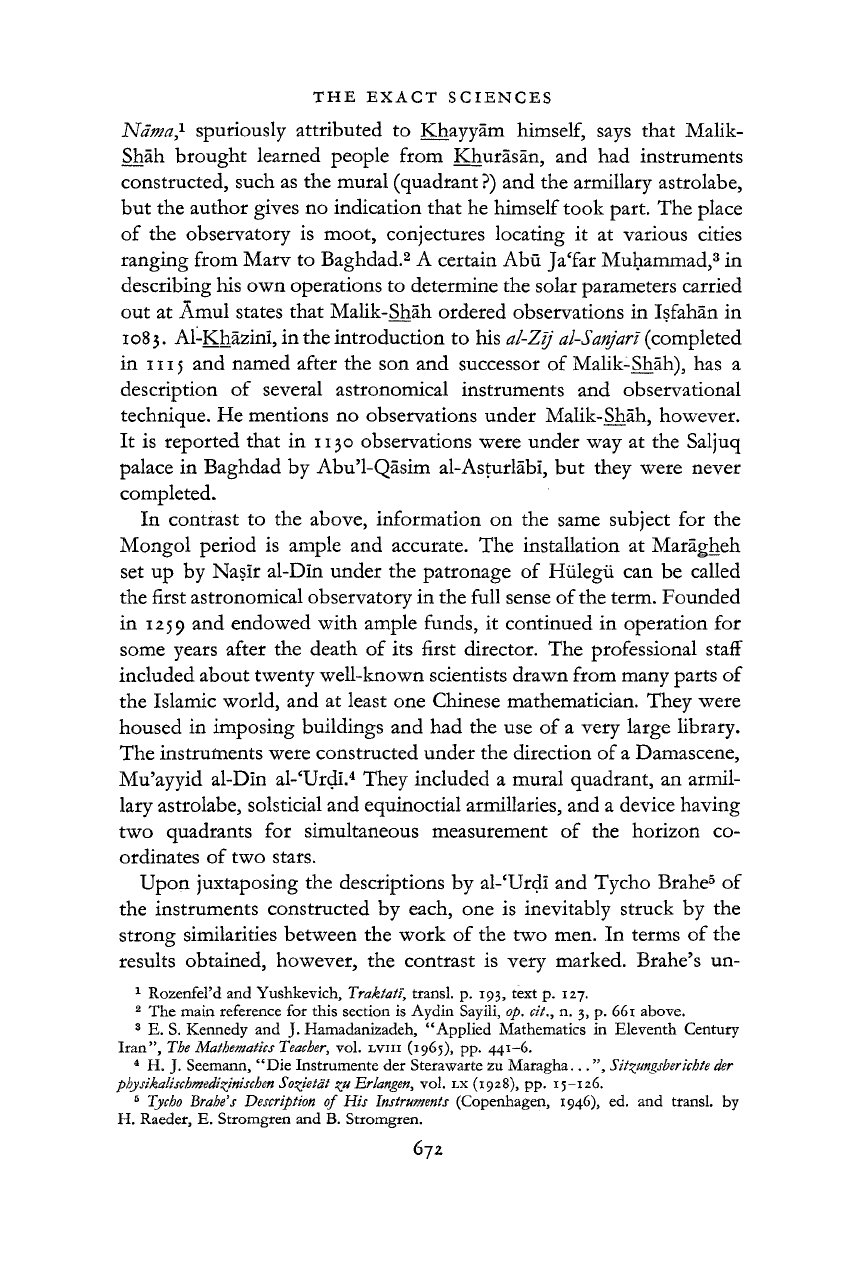
THE EXACT SCIENCES
672
Näma}
spuriously attributed to Khayyam himself, says
that
Malik-
Shäh brought learned people from Khurasan, and had instruments
constructed, such as the mural (quadrant
?)
and the armillary astrolabe,
but the author
gives
no indication
that
he himself took
part.
The place
of
the observatory is moot, conjectures locating it at various cities
ranging from Marv to Baghdad.
2
A certain Abu Ja'far Muhammad,
3
in
describing
his own operations to determine the solar parameters carried
out at Amul states
that
Malik-Shäh ordered observations in Isfahan in
1083.
Al-Khäzini,
in the introduction to his al-Zij al-Sanjari (completed
in
1115
and named after the son and successor of
Malik-Shäh),
has a
description of several astronomical instruments and observational
technique. He mentions no observations under Malik-Shäh, however.
It is reported
that
in 1130 observations were under way at the Saljuq
palace
in Baghdad by Abu'l-Qäsim al-Asturläbi, but they were never
completed.
In contrast to the above, information on the same subject for the
Mongol
period is ample and accurate. The installation at Marägheh
set up by Nasir al-Din under the patronage of Hülegü can be called
the first astronomical observatory in the full sense of the term. Founded
in 1259 and endowed with ample funds, it continued in operation for
some years after the death of its first director. The professional staff
included about twenty well-known scientists drawn from many
parts
of
the Islamic world, and at least one Chinese mathematician. They were
housed in imposing buildings and had the use of a very large library.
The
instruments were constructed under the direction of a Damascene,
Mu'ayyid
al-Din al-'Urdi.
4
They included a mural quadrant, an armil-
lary
astrolabe, solsticial and equinoctial armillaries, and a device having
two
quadrants for simultaneous measurement of the horizon co-
ordinates of two stars.
Upon
juxtaposing the descriptions by al-'Urdi and Tycho Brahe
5
of
the instruments constructed by each, one is inevitably struck by the
strong similarities between the work of the two men. In terms of the
results obtained, however, the contrast is very marked. Brahe's un-
1
Rozenfel'd
and
Yushkevich,
Traktat'i,
transí,
p. 193,
text
p. 127.
2
The
main
reference
for
this
section
is
Aydin
Sayili,
op. tit., n. 3, p. 661
above.
3
E. S.
Kennedy
and J.
Hamadanizadeh,
"Applied
Mathematics
in
Eleventh
Century
Iran",
The
Mathematics
Teacher,
vol.
LVIII
(1965),
pp.
441-6.
4
H. J.
Seemann,
"Die
Instrumente
der
Sterawarte
zu
Maragha...",
Sitzungsberichte
der
physikalischmedi^inischen
Sozietät
%u
Erlangen,
vol.
LX
(1928),
pp. 15-126.
5
Tycho
Brahe''s
Description
of His
Instruments
(Copenhagen,
1946),
ed. and
transí,
by
H.
Raeder,
Е.
Stromgren
and В.
Stromgren.
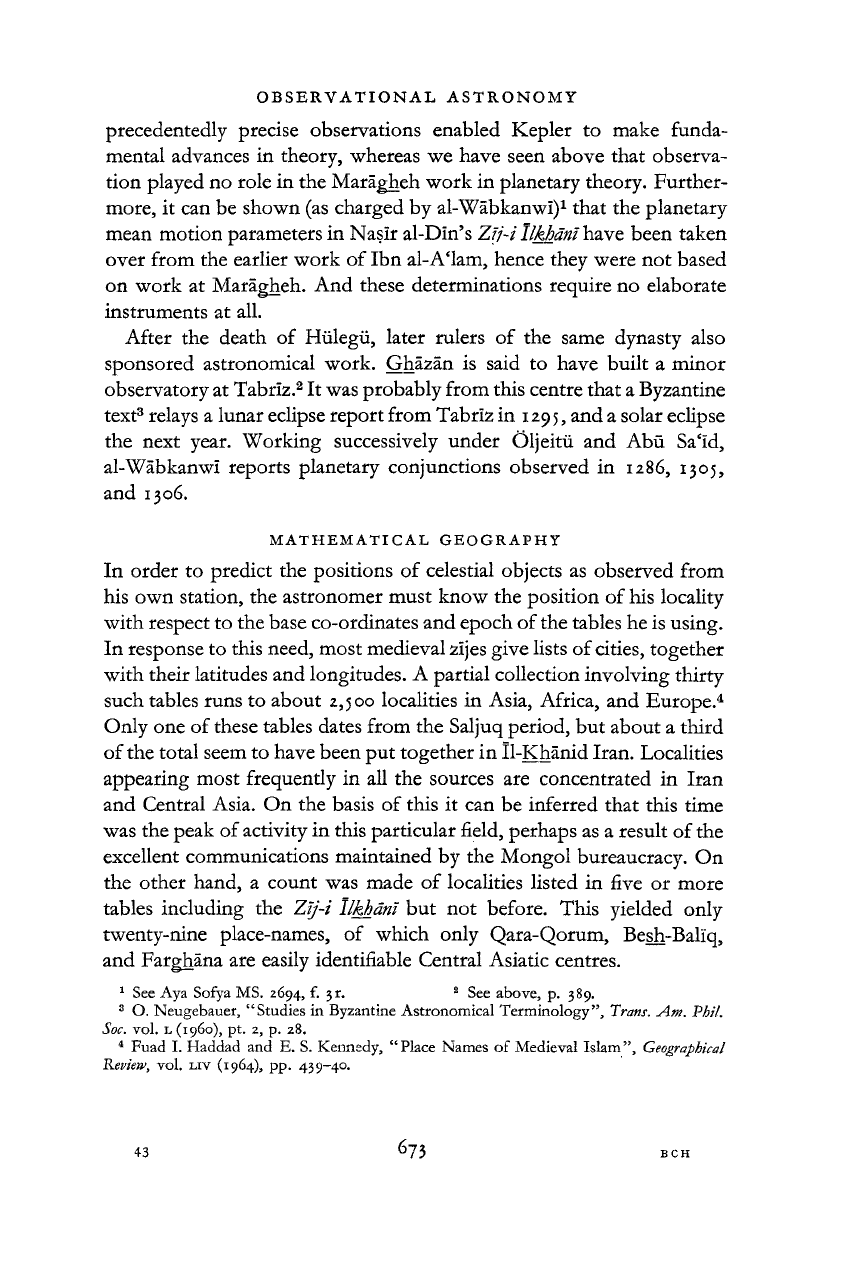
OBSERVATIONAL
ASTRONOMY
43
673
BCH
precedentedly precise observations enabled Kepler to make funda-
mental advances in theory, whereas we have seen above
that
observa-
tion played no role in the Mara
gheh work in planetary theory. Further-
more, it can be shown (as charged by
al-Wabkanwi)
1
that
the planetary
mean motion parameters in Nasir al-Dln's Zij-i
Ilkhdm
have been taken
over
from the earlier work of Ibn
al-A'lam,
hence they were not based
on work at Mara
gheh. And these determinations require no elaborate
instruments at all.
After
the death of Hulegu, later rulers of the same dynasty also
sponsored astronomical work. Ghazan is said to have built a minor
observatory at Tabriz.
2
It was probably from this centre
that
a Byzantine
text
3
relays a lunar eclipse report from Tabriz in
1295,
and a solar eclipse
the next year. Working successively under Oljeitu and Abu Sa'Id,
al-Wabkanwi
reports planetary conjunctions observed in 1286, 1305,
and 1306.
MATHEMATICAL
GEOGRAPHY
In order to predict the positions of celestial objects as observed from
his own station, the astronomer must know the position of his locality
with
respect to the base co-ordinates and epoch of the tables he is using.
In response to this need, most medieval zijes
give
lists of
cities,
together
with
their latitudes and longitudes. A partial collection
involving
thirty
such tables
runs
to about
2,500
localities in
Asia,
Africa,
and Europe.
4
Only
one of these tables dates from the Saljuq period, but about a third
of
the total seem to have been put together in Il-Khanid
Iran.
Localities
appearing most frequently in all the sources are concentrated in
Iran
and Central
Asia.
On the basis of this it can be inferred
that
this time
was
the peak of
activity
in this particular field, perhaps as a result of the
excellent
communications maintained by the Mongol bureaucracy. On
the other hand, a count was made of localities listed in
five
or more
tables including the Zij-i
Ilkhdm
but not before. This yielded only
twenty-nine place-names, of which only Qara-Qorum, Besh-Baliq,
and Far
ghana are easily identifiable Central Asiatic centres.
1
See Aya
Sofya
MS.
2694,
f.
3
г.
2
See
above,
p. 389.
3
O.
Neugebauer,
"Studies
in
Byzantine
Astronomical
Terminology",
Trans.
Am.
Phil.
Soc. vol. L
(i960),
pt. 2, p. 28.
4
Fuad
I.
Haddad
and E. S.
Kennedy,
"Place
Names
of
Medieval
Islam",
Geographical
Review,
vol.
LIV
(1964),
pp.
439-40.
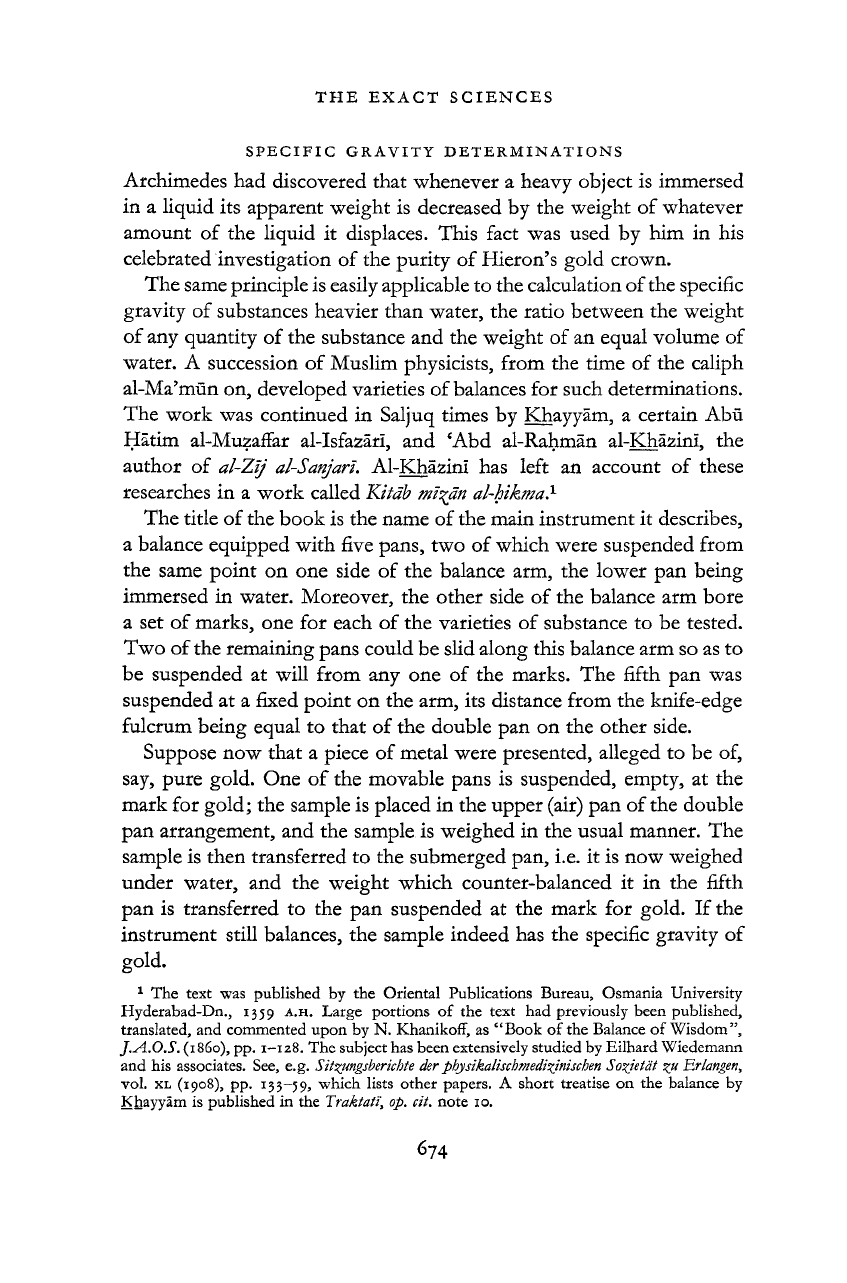
THE EXACT SCIENCES
SPECIFIC GRAVITY DETERMINATIONS
Archimedes
had discovered
that
whenever a heavy object is immersed
in a liquid its apparent weight is decreased by the weight of whatever
amount of the liquid it displaces. This fact was used by him in his
celebrated investigation of the purity of Hieron's gold crown.
The
same principle is easily applicable to the calculation
of
the specific
gravity
of substances heavier
than
water, the ratio between the weight
of
any quantity of the substance and the weight of an equal volume of
water. A succession of Muslim physicists, from the time of the caliph
al-Ma'mün on, developed varieties of balances for such determinations.
The
work was continued in Saljuq times by Khayyam, a certain Abu
Hätim al-Muzaffar al-Isfazäri, and 'Abd al-Rahmän al-Khäzini, the
author of al-Zij al-Sanjari.
Al-Khäzini
has left an account of these
researches in a work called Kitäb
mi^än
al-hikma.
1
The
title of the book is the name of the main instrument it describes,
a balance equipped with
five
pans, two of which were suspended from
the same point on one side of the balance arm, the lower pan being
immersed in water. Moreover, the other side of the balance arm bore
a set of marks, one for each of the varieties of substance to be tested.
Two
of the remaining pans could be slid along this balance arm so as to
be suspended at
will
from any one of the marks. The fifth pan was
suspended at a fixed point on the arm, its distance from the knife-edge
fulcrum being equal to
that
of the double pan on the other side.
Suppose now
that
a piece of metal were presented, alleged to be of,
say,
pure gold. One of the movable pans is suspended, empty, at the
mark for gold; the sample is placed in the upper (air) pan of the double
pan arrangement, and the sample is weighed in the usual manner. The
sample is then transferred to the submerged pan, i.e. it is now weighed
under water, and the weight which counter-balanced it in the fifth
pan is transferred to the pan suspended at the mark for gold. If the
instrument still balances, the sample indeed has the specific gravity of
gold.
1
The
text
was
published
by the
Oriental
Publications
Bureau,
Osmania
University
Hyderabad-Dn.,
1359 A.H.
Large
portions
of the
text
had
previously
been
published,
translated,
and
commented
upon
by N.
Khanikoff,
as
"Book
of the
Balance
of
Wisdom",
J.A.O.S.
(i860),
pp. 1-128. The
subject
has
been
extensively
studied
by
Eilhard
Wiedemann
and his
associates.
See, e.g.
Sitzungsberichte
der
physikalischmedi^inischen
Sozietät
%u
Erlangen,
vol. XL
(1908),
pp.
133-59,
which
lists
other
papers.
A
short
treatise
on the
balance
by
Khayyam
is
published
in the
Traktatz,
op. cit.
note
10.
674
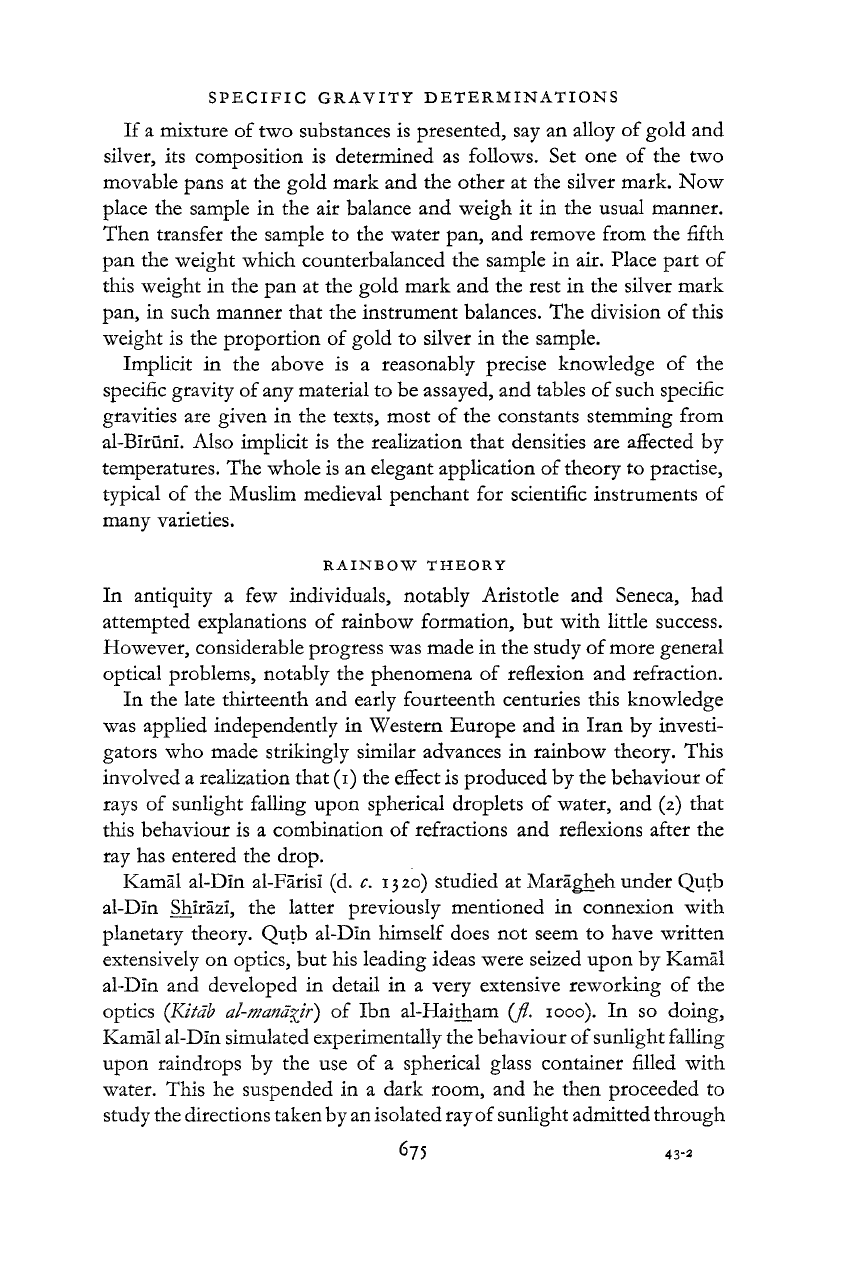
SPECIFIC
GRAVITY
DETERMINATIONS
If
a mixture of two substances is presented, say an alloy of gold and
silver,
its composition is determined as
follows.
Set one of the two
movable
pans at the gold mark and the other at the silver mark. Now
place
the sample in the air balance and weigh it in the usual manner.
Then
transfer the sample to the water pan, and remove from the fifth
pan the weight which counterbalanced the sample in air. Place
part
of
this weight in the pan at the gold mark and the rest in the silver mark
pan, in such manner
that
the instrument balances. The division of this
weight
is the proportion of gold to silver in the sample.
Implicit
in the above is a reasonably precise knowledge of the
specific
gravity of any material to be assayed, and tables of such specific
gravities
are given in the texts, most of the constants stemming from
al-Biruni.
Also
implicit is the realization
that
densities are affected by
temperatures. The whole is an elegant application of theory to practise,
typical
of the Muslim medieval penchant for scientific instruments of
many varieties.
RAINBOW THEORY
In antiquity a few individuals, notably Aristotle and Seneca, had
attempted explanations of rainbow formation, but with little success.
However,
considerable progress was made in the study of more general
optical
problems, notably the phenomena of reflexion and refraction.
In the late thirteenth and early fourteenth centuries this knowledge
was
applied independently in Western Europe and in
Iran
by investi-
gators who made strikingly similar advances in rainbow theory. This
involved
a realization
that
(i) the effect is produced by the behaviour of
rays
of sunlight falling upon spherical droplets of water, and
(2)
that
this behaviour is a combination of refractions and reflexions after the
ray has entered the drop.
Kamal
al-Dln al-Farisi (d. c. 1320) studied at Maragheh under Qutb
al-Dln
Shirazi, the latter previously mentioned in connexion with
planetary theory. Qutb al-Dln himself does not seem to have written
extensively
on optics, but his leading ideas were seized upon by Kamal
al-Dln
and developed in detail in a very extensive reworking of the
optics
(Kitah
al-mand^ir)
of Ibn al-Haitham (/?. 1000). In so doing,
Kamal
al-Din simulated experimentally the behaviour of sunlight falling
upon raindrops by the use of a spherical glass container filled with
water. This he suspended in a dark room, and he then proceeded to
study the directions taken by an isolated ray
of
sunlight admitted through
675
43-2
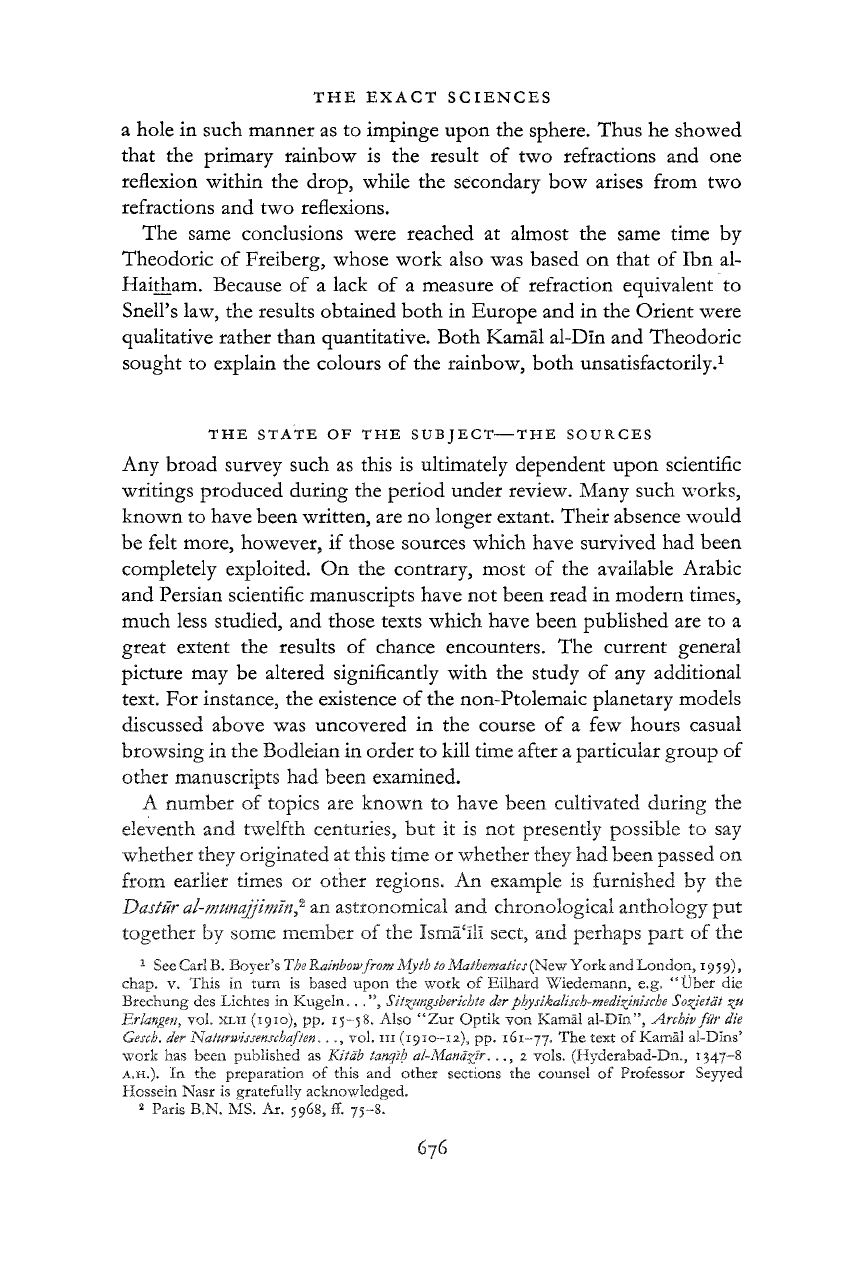
THE EXACT SCIENCES
676
a hole in such manner as to impinge upon the sphere. Thus he showed
that
the primary rainbow is the result of two refractions and one
reflexion
within the drop, while the secondary bow arises from two
refractions and two reflexions.
The
same conclusions were reached at almost the same time by
Theodoric
of Freiberg, whose work also was based on
that
of Ibn al-
Haitham. Because of a lack of a measure of refraction equivalent to
SnelPs
law, the results obtained both in Europe and in the Orient were
qualitative
rather
than
quantitative. Both Kamäl al-Dln and Theodoric
sought to explain the colours of the rainbow, both unsatisfactorily.
1
THE
STATE
OF THE
SUBJECT—THE
SOURCES
Any
broad survey such as this is ultimately dependent upon scientific
writings
produced during the period under review. Many such works,
known
to have been written, are no longer extant. Their absence would
be felt more, however, if those sources which have survived had been
completely
exploited. On the contrary, most of the available Arabic
and Persian scientific manuscripts have not been read in modern times,
much less studied, and those texts which have been published are to a
great extent the results of chance encounters. The current general
picture may be altered significantly with the study of any additional
text. For instance, the existence of the non-Ptolemaic planetary models
discussed
above was uncovered in the course of a few hours casual
browsing
in the Bodleian in order to
kill
time after a particular group of
other manuscripts had been examined.
A
number of topics are known to have been cultivated during the
eleventh
and twelfth centuries, but it is not presently possible to say
whether they originated at this time or whether they had been passed on
from
earlier times or other regions. An example is furnished by the
Dasiür
al-mtmajjimin^
2
an astronomical and chronological anthology put
together by some member of the Ismä'IlI sect, and perhaps
part
of the
1
See Carl B.
Boyer's
The
Rainbowfrom
Myth
to
Mathematics
(New
York
and
London,
1959),
chap.
v.
This
in
turn
is
based
upon
the
work
of
Eilhard
Wiedemann,
e.g. "Über die
Brechung
des
Lichtes
in Kugeln.. .Sitzungsberichte der physikalisch-medizinische Sozietät %u
Erlangen, vol.
XLII
(1910),
pp.
15-58.
Also
"Zur
Optik
von
Kamäl
al-DIn",
Archiv für die
Gesch.
der
Naturwissenschaften...,
vol. in
(1910-12),
pp. 161-77. The
text
of
Kamäl
al-DIns*
work
has
been
published
as Kitäb
tanqih
al-ManäzJr...,
2
vols.
(Hyderabad-Dn.,
1347-8
A.H.).
In the
preparation
of
this
and
other
sections
the
counsel
of
Professor
Seyyed
Hossein
Nasr
is gratefully
acknowledged.
2
Paris
B.N. MS. Ar.
5968,
ff. 75-8.
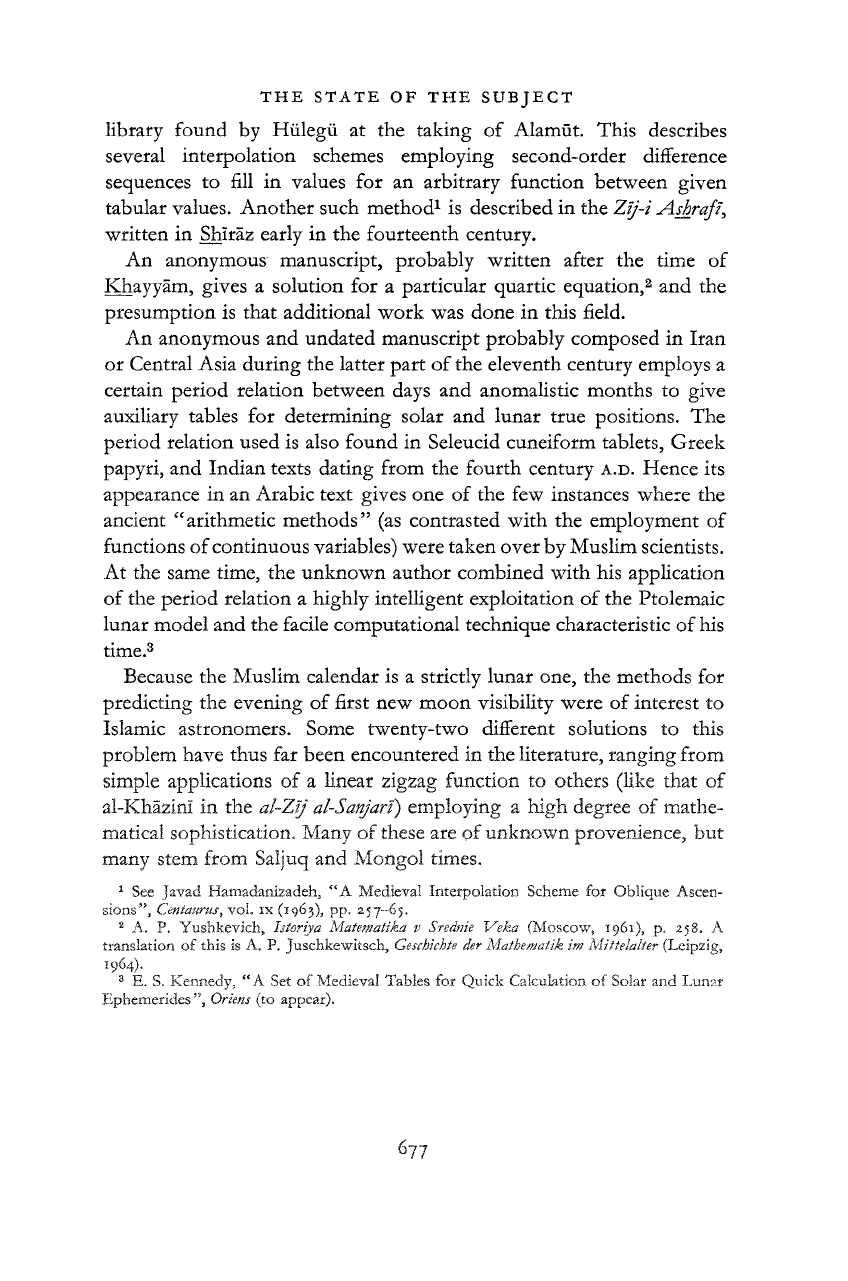
THE STATE OF THE SUBJECT
library found by Hulegii at the taking of Alamiit. This describes
several
interpolation schemes employing second-order difference
sequences to
fill
in values for an arbitrary function between
given
tabular values. Another such method
1
is described in the Zij-i Asbrafz,
written in Shiraz early in the fourteenth century.
An
anonymous manuscript, probably written after the time of
Khayyam,
gives
a solution for a particular quartic equation,
2
and the
presumption is
that
additional work w
T
as done in this field.
An
anonymous and undated manuscript probably composed in
Iran
or Central
Asia
during the latter
part
of the eleventh century employs a
certain period relation between days and anomalistic months to
give
auxiliary
tables for determining solar and lunar
true
positions. The
period relation used is also found in Seleucid cuneiform tablets, Greek
papyri,
and Indian texts dating from the fourth century
A.D.
Hence its
appearance in an Arabic text
gives
one of the few instances where the
ancient "arithmetic methods" (as contrasted with the employment of
functions
of
continuous variables) were taken over by Muslim scientists.
At
the same time, the unknown
author
combined with his application
of
the period relation a highly intelligent exploitation of the Ptolemaic
lunar model and the
facile
computational technique characteristic of his
time.
3
Because
the Muslim calendar is a strictly lunar one, the methods for
predicting the evening of first new moon visibility were of interest to
Islamic astronomers. Some twenty-two different solutions to this
problem have
thus
far been encountered in the literature, ranging from
simple applications of a linear
zigzag
function to others (like
that
of
al-Khazini
in the al-Zij al-Sanjari) employing a high degree of mathe-
matical sophistication. Many of these are of unknown provenience, but
many stem from Saljuq and Mongol times.
1
See
Javad
Hamadanizadeh,
"A
Medieval
Interpolation
Scheme
for
Oblique
Ascen-
sions",
Centawus, vol. ix
(1963),
pp.
257-65.
2
A. P.
Yushkevich,
htoriya
Matematika
v Srednie Veka
(Moscow,
1961),
p. 258. A
translation
of
this
is A. P.
Juschkewitsch,
Geschichte der Mathematik im Mittelalter
(Leipzig,
1964).
3
E. S.
Kennedy,
"A Set of
Medieval Tables
for
Quick
Calculation
of
Solar
and
Lunar
Ephemerides
", Oriens (to
appear).
677
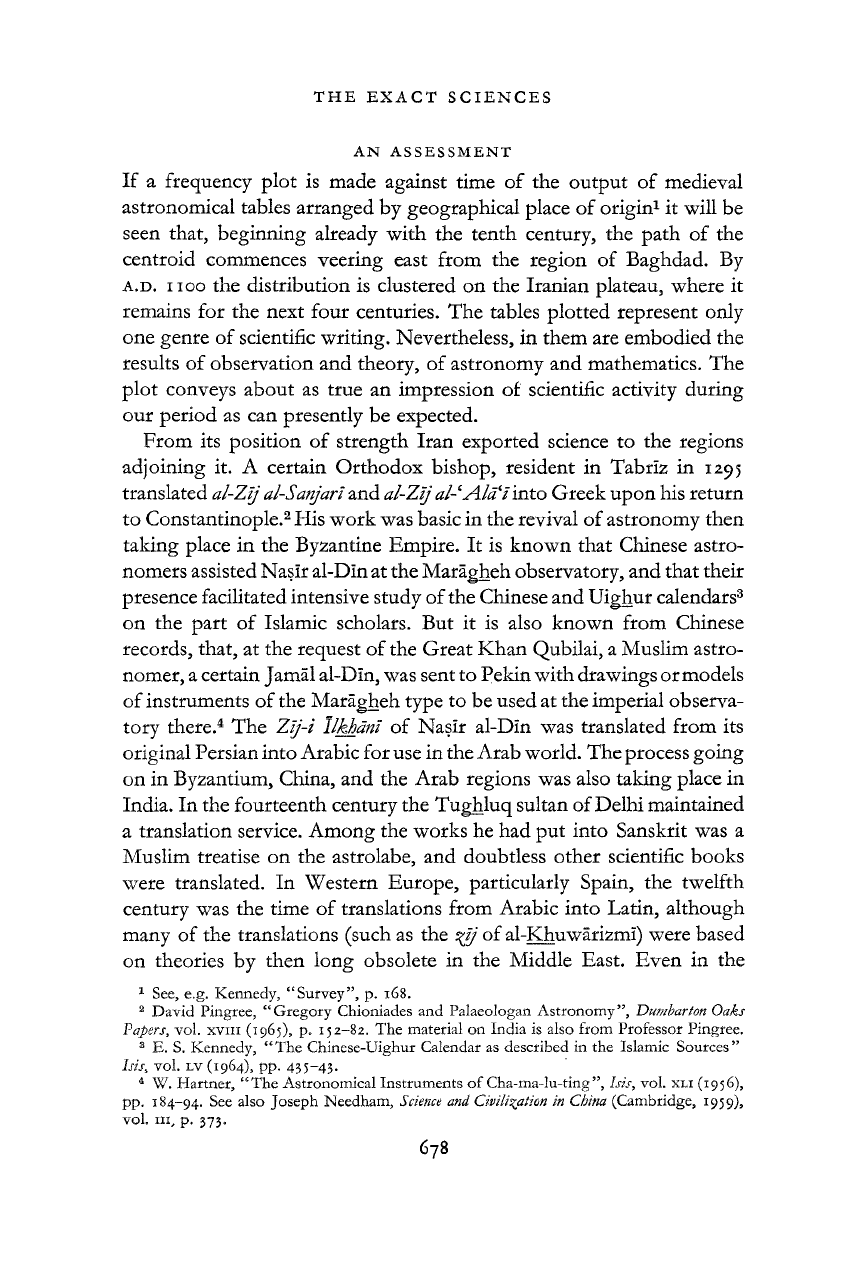
THE EXACT SCIENCES
AN
ASSESSMENT
If
a
frequency plot
is
made against time
of the
output
of
medieval
astronomical tables arranged
by
geographical place
of
origin
1
it
will
be
seen
that,
beginning already with
the
tenth
century,
the
path
of the
centroid commences veering east from
the
region
of
Baghdad.
By
A.D.
IIOO
the
distribution
is
clustered
on the
Iranian
plateau, where
it
remains
for the
next four centuries.
The
tables plotted represent only
one genre
of
scientific writing. Nevertheless,
in
them
are
embodied
the
results
of
observation
and
theory,
of
astronomy
and
mathematics.
The
plot conveys about
as
true
an
impression
of
scientific activity during
our period
as can
presently
be
expected.
From
its
position
of
strength
Iran
exported science
to the
regions
adjoining
it. A
certain Orthodox bishop, resident
in
Tabriz
in 1295
translated al-Zij
al-Sanjari
and
al-Zij
al-Ald^iinto Greek upon his
return
to Constantinople.
2
His work was basic
in the
revival of astronomy
then
taking place
in the
Byzantine Empire.
It is
known
that
Chinese astro-
nomers assisted Nasir al-Dln at the Mara
gheh observatory,
and
that
their
presence facilitated intensive study
of
the Chinese
and
Uighur calendars
3
on
the
part
of
Islamic scholars.
But it is
also known from Chinese
records,
that,
at the
request
of
the Great Khan Qubilai,
a
Muslim astro-
nomer, a certain Jamil al-Dln, was sent to Pekin with drawings or models
of
instruments
of
the Maragheh type
to be
used
at the
imperial observa-
tory there.
4
The
Zij-i Ilkhdni
of
Nasir al-Dln
was
translated from
its
original Persian into
Arabic
for use in the Arab world. The process going
on
in
Byzantium, China,
and the
Arab regions was also taking place
in
India.
In the
fourteenth century
the
Tughluq sultan
of
Delhi
maintained
a translation service. Among
the
works
he had put
into Sanskrit
was a
Muslim
treatise
on the
astrolabe,
and
doubtless other scientific books
were
translated.
In
Western Europe, particularly Spain,
the
twelfth
century
was the
time
of
translations from Arabic into Latin, although
many
of the
translations (such
as the
%ij
of
al-Khuwarizmi)
were based
on theories
by
then
long obsolete
in the
Middle East. Even
in the
1
See, e.g. Kennedy, "Survey", p. 168.
2
David Pingree, "Gregory Chioniades and Palaeologan Astronomy",
Dumbarton
Oaks
Papers,
vol.
XVIII
(1965), p. 152-82. The material on India is
also
from Professor Pingree.
3
E. S. Kennedy, "The Chinese-Uighur Calendar as described in the Islamic Sources"
ISIS,
VOl.
LV
(1964), pp. 435-43.
4
W. Hartner, "The Astronomical Instruments of Cha-ma-lu-ting",
Isis,
vol.
XLI
(1956),
pp.
184-94. See
also
Joseph Needham, Science and
Civilisation
in China (Cambridge, 1959),
vol. in, p. 373.
678
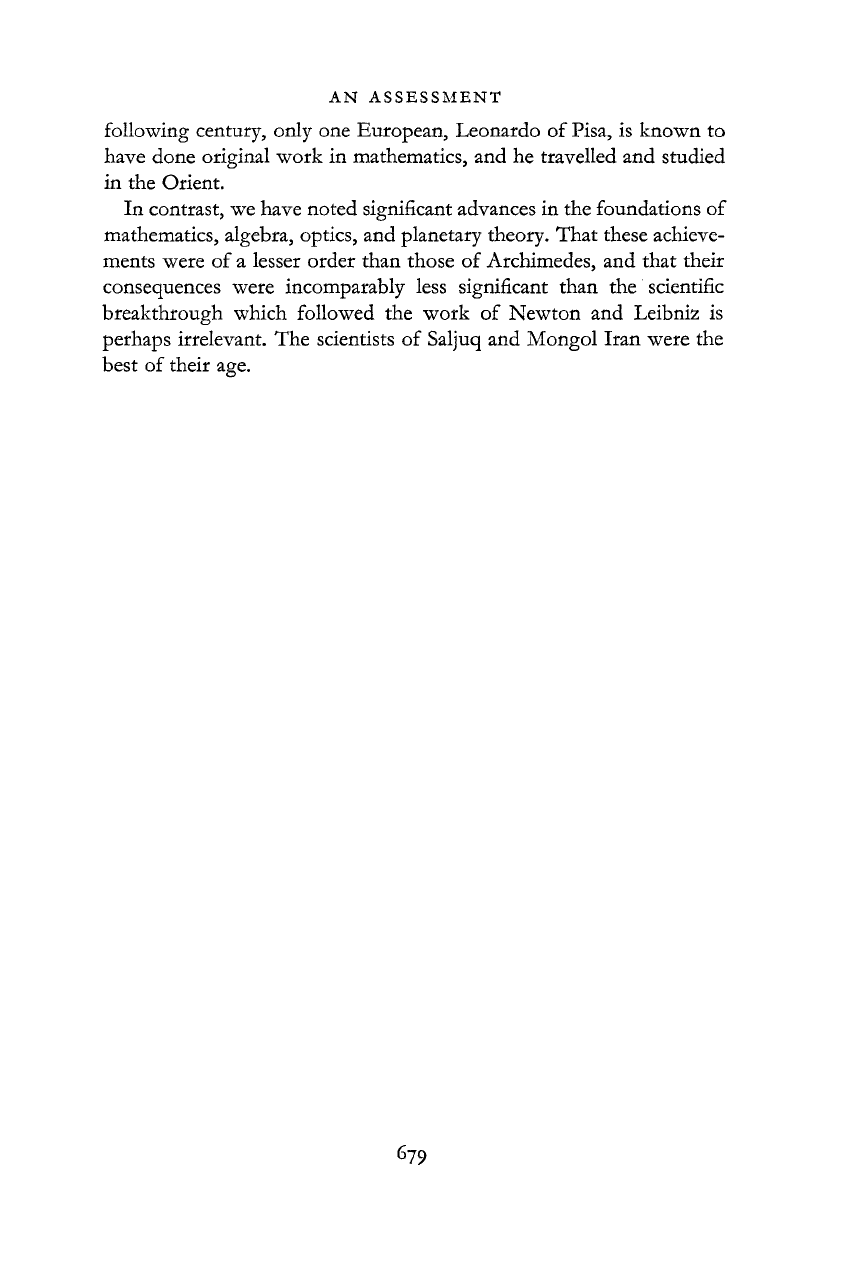
AN ASSESSMENT
following
century, only one European, Leonardo of Pisa, is known to
have done original work in mathematics, and he travelled and studied
in the Orient.
In contrast, we have noted significant advances in the foundations of
mathematics, algebra, optics, and planetary theory. That these achieve-
ments were of a lesser order
than
those of Archimedes, and
that
their
consequences were incomparably less significant
than
the scientific
breakthrough which followed the work of Newton and Leibniz is
perhaps irrelevant. The scientists of Saljuq and Mongol
Iran
were the
best of their age.
679
